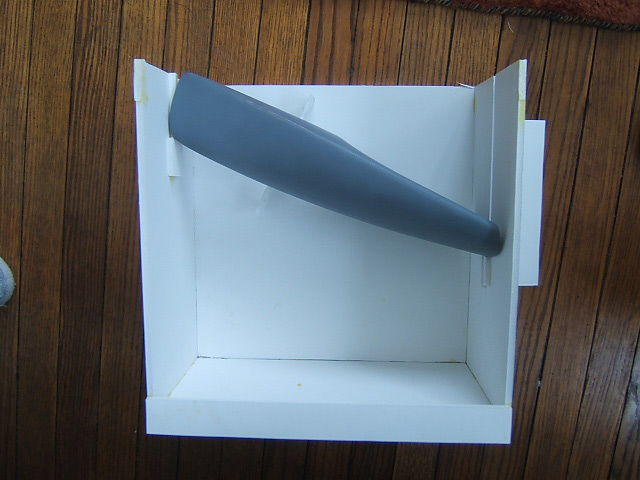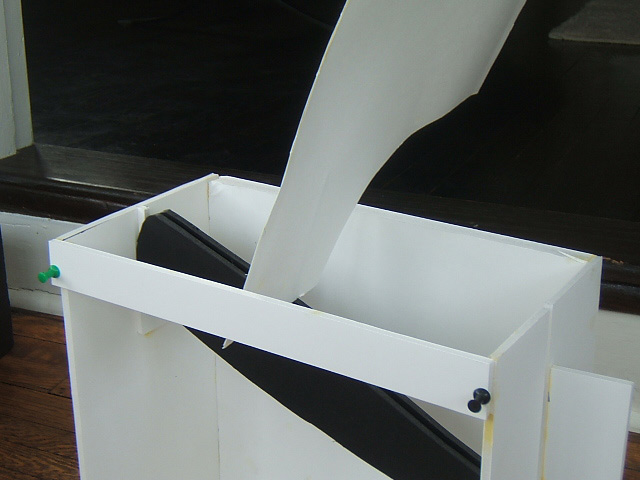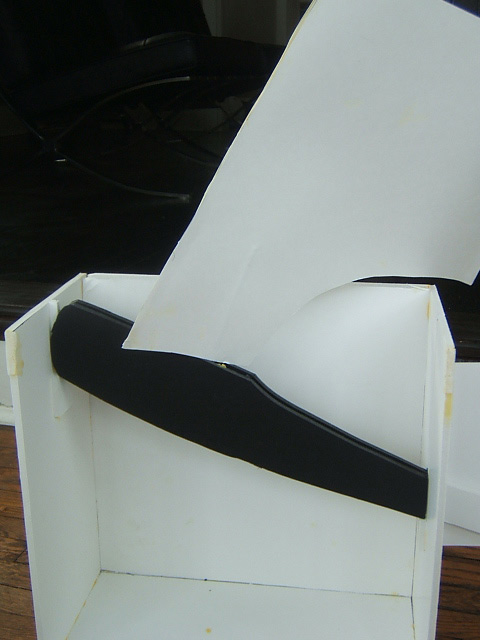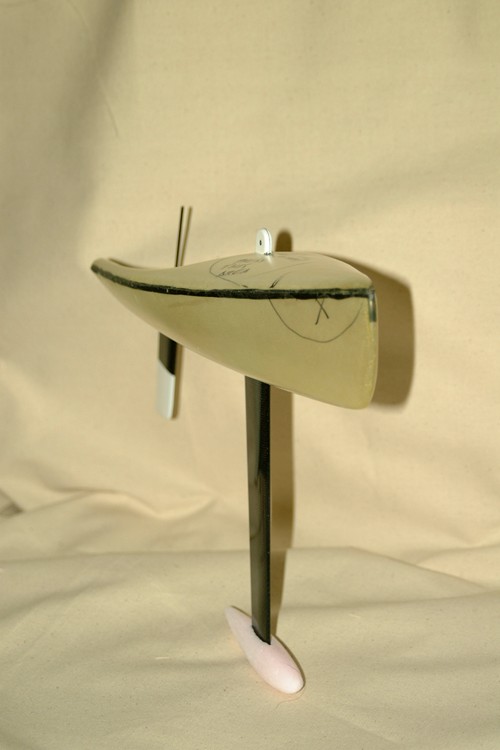I got a package of eight throwaway lithiums (Energizers) at Rite-Aid for $15. I saw them at Radio Shack and they were a lot more expensive
Bob
Trevor,
I Don’t actually plan on finnishing that hull at all.
Its designed displacment is also 400g. I have built and sailed boats with 300g displacment before.I don’t regard 400g as ultra light.
After my last round of hull testing I have discovered a different path to explore:)
Re weights.
All yours seem ok to me.
I have built a finnished hull and deck at 16grams.(female moulded glass 3x 0.75oz cloth. with carbon “stringers”) so 40 grams for a hull deck and appendages is quite easily possible.
A rig for 20grams…no problem there.as Trevor mentions I have a 10g rig.
A sloop rig for 20 grams easily possible by using innovative methods. 
My current radio setup is 6 g rudder servo
16 gram metal geared servo for sail control.has 4kg torque,though my rig designs have halved the ammount of torque needed,so can quite possibly go smaller here as well.
10 gram Futaba RX with casing etc stripped.
E2 batteries are $10NZ a pair here…thats about$8 US…$22 for 4 of em seems to much.
They are not hard to find at all.
The Blue Sky skiff should peform well in light to moderate air…I worry about your high centre of effort and the design of a “B” rig.
Though of course smaller rigs need not be a design issue if the boat is only designed for “Internet racing”
My design path is for a boat capable of good performance over the whole wind range and so quite possibly a different design brief to yours altogether.
Assuming a Footy will NOT exceed hull speed, it seems to me that ensuring that the rig doesn’t over power the boat is more crucial than most other design issues. That said, a higher lift coefficient is GOOD because less sail area is required.
Brett, your uni-rig is infinitely adaptable for SA and CE and thus is a good test platform. Given the mast pocket you may also be able to introduce foam camber inducers and perhaps increase the CL. I’m eager to see how it will depower in gusts.
My split rig likewise is easily adaptable for SA and CE and depowers efficiently. Camber inducers can also be introduced.
As for the Blue Sky:
I need to get pics up so you can see the rig in place … the CE IS high but not as high as you might imagine (and not as high as we’re seeing on the American Footies pictured on the Yahoo site). The split rig you see in the previous pics was designed for light air venues; and believe it or not, I may be tempted to make the rig even bigger.
Thus, your point about Blue Sky being a light air boat is accurate. I’ve mentioned my concern about there being too little bouancy up front. Until hydro testing, I won’t know for sure but I’m guessing a compromise is going to have to be made between keeping longitudinal mass stern biased and keeping Blue Sky on her lines (thus I like your idea of adding discplacement with the rudder).
Boats like Blue Sky will appeal to the eye (and I admit that that’s a big part of why she’s drawn as she is), but they’re not the most efficient performers. Your hull is interesting and one worth considering. Some points in its favour:
Doug Lord (love him or hate him) urges strongly for a lwl / beam ratio more in line with what you’ve drawn. In essence a single catamaran hull with low hanging ballast.
Parasitic drag in boats of Footy size is considerable so any reducuction in whetted area will allow for less rig and fewer associated problems. Your hull is certainly capable of achieving less whetted area.
Lester Gilbert has written a piece about round sections and their effect on tracking … even though you haven’t utilized the theory entirely, you’re much closer … your hull SHOULD track better than a Blue Sky
Not sure what your designated water line was but you should easily be able to keep the transom out of the water … that’s an open question with boats like Blue Sky (and in fact most footy’s … pictures show them dragging a hole through the water … again requiring more rig than necessary)
As for chop … I’m worried Blue Sky will get swamped and trip all over herself. I’d be less worried about that with your hull.
Light air … my boats is going LOOK better !!! :lol: :lol: :lol:
Curious … is it something to do with the design itself that has you choosing to move on? You’ve got me curious about the new direction you say you’re exploring. I’m asking because we now have a problem … the Skiffs (Blue Sky, LajaBless) need tested against a variety of platforms and unless you’re going to build your hull, I’m going to have to … and damn it all, one boat is already too much. :scared:
Trevor
In the US, they are widely available in camera departments of stores like Wal-Mart. A little pricey, and not rechargeable, but they are light, and claim to have a much longer life than alkalines.
I plan to use them for competition, and stick to my NiMHs for fooling around.
–Doug
Trevor,
It sounds like you’re pursuing a logical approach to Footy design. Just like you we’re all trying things and hoping it will result in a fast boat. Limited testing and head to head racing is the main data gap at this time. I encourage you to get to one of the regattas organized around Brett’s NZL Classic. If you can sail a boat great. Just observing will provide more insight into how these boats work than any amount of mental gymnastics.
The recent video of the scow vs American Footy shows acceleration differences but similar top speeds. In a class that often will be dominated by puffy, low surface winds, I wouldn’t want to give up acceleration. I’m betting lots of races will be little sprints as the boats find the shifty winds. In places with stronger/consistant winds, a rig change may not be enough. You may want to sail a whole other boat.
And just for the record…that lithium battery pack was $22 for an 8 pack. Still pricey but not outrageous. I still use NiMH because that’s what I already own. If I was racing, I migh spring for the lighter lithiums, maybe. I’m pretty cheap.
Keep up the good work.
Hi Trevor,
Your opening statement assuming that footys won’t exceed hull speed is incorrect as far as I can tell.
I spent 4 days a month or so back testing 12 different hulls with a rudimentry towing device.The results were very interesting.
I won’t share everything I know on a public forum though…this info is hard won…12 different designs represents 5 years work and development for me.
It doesn’t seem fair to pass on what I now “think” I know so easily…I am sure you can relate to that somewhat.I have tended to share more than most in this area.
there is quite a bit of info around on comparing designs if you read everything that everyone has ever written and start reading between the lines and forming your own conclusions…of course upcoming race results will be a real boon in this area. I expect the results of the postal classic will be over analyzed to death!
Anyway…after the testing I spent some time trying to find connections with what I saw on the water to what the Hullform software is able to tell me.
I think I have found some links…and hence a way to predict the behaviour of various hulls form a hull form model in a fairly crude way.
I will state some fairly obvious findings though.
Footys regulary sail faster than hull speed. less than 1/3 the size of an IOM and approx 1/2 as fast.They sail at froude numbers of about 0.4.
more efficent upwind machines than any other class of yacht that I am aware of…its the cube law in reverse.
This being established should show a new path for the hull designs.
Immersed transoms and high prismatic designs are likely to be better candidates at these froude numbers.
hence why the design I showed will likely progress no further for the time being…I can’t finnish them all…I have more than 20 different hulls in my workshop.
Interestingly enough one of my earliest designs showed the way forward as far has hull design was concerned…and one I just carved from a peice of foam by eye as well! so much for advanced CAD and hullform software!
Brett
Hmmm … glad I didn’t read this yesterday evening because I would have been up all night pondering.
Your assertions being the case, Footy designers will eventually need to know why and how the boats are going as fast as they are … even so, before that is figured out, orthodoxy dictates that a test program should include
[ul]
[li]displacement hulls
[/li][li]semi-displacement hulls
[/li][li]planing hulls
[/li][/ul]
… each having its own strengths and suitabilty over a range of conditions.
To date, many of the hulls I’ve seen could arguably be classed as semi-displacement hulls … given their aft deadrise and entry they remind me of the big powerboats on the great lakes. I haven’t seen a pure planing hull yet … even Blue Sky v1 doesn’t really come close. And there do seem to be some nice displacement hulls around.
So, what is it in your opinion that these hulls are doing when they exceed hull speed … are they planing? Are the hulls powerful enough to muscle their way through the water? Or, are we simply applying a different formula which will also max out, only at a different theoretical top speed.
(The Balmain Bugs (sp?) seem instructive in that they surely wouldn’t be carrying all that sail only to achieve hull speed, yet they sure don’t look like they are going to plane.)
I spent 4 days a month or so back testing 12 different hulls with a rudimentry towing device.The results were very interesting. I won’t share everything I know on a public forum though…this info is hard won…12 different designs represents 5 years work and development for me. It doesn’t seem fair to pass on what I now “think” I know so easily…I am sure you can relate to that somewhat.I have tended to share more than most in this area.
Sympathy here, and thanks for sharing what you have … I tend to be an open source guy in as many ways as are practical, but being in the creative industries makes me aware of how intellectual effort can be subsumed by those who put no effort into a project what-so-ever.
That said … my curiousity is aroused even further  . If you weren’t a world away I’d start buying you beers and plying you with schwag :lol:
. If you weren’t a world away I’d start buying you beers and plying you with schwag :lol:
Trevor
>>>
So, what is it in your opinion that these hulls are doing when they exceed hull speed … are they planing? Are the hulls powerful enough to muscle their way through the water? Or, are we simply applying a different formula which will also max out, only at a different theoretical top speed.
<<<
I think this is the main point. I doubt any Footy will plane, at least not on anything like a regular basis, and under control. Nor are they likely to “muscle” their way through a bow wave like narrow catamaran hulls. Thus, I’d say they are limited to hull speed. That hull speed may not be predicted by the usual formula, which in any event was never more than an approximation for any given hull. If we define “hull speed” to be that speed where a large increase in thrust produces only a small increase in speed, a Footy will not exceed hull speed. The concept of “hull speed” always left room for small speed improvements by altering hull shape, or even by adding thrust. To put it another way, “hull speed” was never an absolute such as sonic velocity (which varies with pressure and temperature, but is the same no matter what airfoil is flying through it).
Mike Biggs
As promised … pics show shadows of Blue Sky upwind, reaching and on a run. At no point does the rig touch the sides of the box. Nor at any point does any part of the rig that starts in the box leave the box.
Provided the foot of the sail clears the box, and the the pivot is less than three inches from fore any sail shape will work … CE can be raised or lowered by altering aspect … split rig or uni rig can be utilized as can conventional burmuda with jib.


Trevor
I also don’t believe that Footies will plane. Planing is associated with offwind sailing, reaching and running before the wind. In these points of sail Footies tend to sail bow down, which shifts the dynamic loads all over the place. Planing requires a stable platform to achieve that final thrust that “pops” a hull out of its waveform.
I do agree with Brett that Footies are tremendous performers upwind. Its that characteristic that got me hooked on these little boats in the first place. That and the challenge of getting similar performance out of them offwind.
I understand Brett’s interests in withholding results from his tests of various hull shapes and yet these results are currently the only real head to head comparisons that exist. While the Postal Classic may yield some interesting results the local conditions under which all these time trials will be held are variables that will make a meaningful comparison of different hull shapes not much more useful than “reading between the lines” of the descriptions that have already been published on this forum.
At this early stage of development of the Footy any credible head to head comparisons that are undertaken should be made available here. I credit Brett, Trevor and Nigel most recently, and all the others who have contributed their insights, for making this forum an interesting and useful place to spend some of our precious time. Thanks guys!
I very much agree with Niel, here, about Footy performance at different points of sail. I don’t have the ability to measure the speed of my boats (or even the wind, unfortunately) but Razor and American Footy upwind have surprised a lot of people. I was working hard last season to conquer the downwind issues, even trying a horizontal foil under the stern (seemed to help a bit downwind but with corresponding reduction in upwind performance) and greater volume in the bow (Cutlass.) The only real conclusion I reached was that I haven’t yet solved the problem! The performance tradeoffs resulting from design choices seems exaggerated in Footys relative to other types of boats. That challenge is what hooked me on Footys, too,and I expect it will still be quite a while before it becomes boring.
Hope the ice melts before mid-April.
Bill H
Thoughts on testing a Footy’s potential to plane …
OPTION A
Test an ultra-light-displacement boat that BEGINS on top of the water … Blue Sky Skiff v1 attempted this but was poorly conceived … any planing dinghy however is instructive … in Toronto we have an active I14 class; the 49er is a global boat … both have extremely efficient planing hulls
I’m guessing that if weight issues could be overcome, and if a rig could be properly powered and depowered it IS conceivable that a boat could be built that doesn’t need to “pop” its waveform because it starts almost already there.
OPTION B
Build a boat intended for one thing only …to plane on one predetermined point of sail at the cost of everything else.
Rig, foils, hull form, displacement, balance, cG and everything else is designed ONLY to sail on the chosen point of sail. Start with non-conforming weights if necessary, then adapt to bring boat back into the envelope.
A summers worth of work MAY just result in somebody getting a boat to plane … who knows, as long as planing is the ONLY objective, and every other variable is eliminated (sailing upwind for instance) finding an answer will be that much easier (unless of course somebody stumbles on it by accident).
OPTION C
Use the sports boats such as the Melges 24 as the genesis for a design brief. They use a ton of horsepower to plane downwind. This will be more a rig issue than a hull issue … if you put a big enough engine on anything it will pop out of the water …
Once a boat is planing all bets are off … any sailor knows that once a keelboat is out of the water, a wandering mind can lead to disaster … how you’d control a footy is beyond me. Secondly and regretably, the easiest way to test it would be to build a non-conforming boat.
Anybody got a ton of energy and a summer’s worth of free time? 
Trevor Paetkau
The Blue Sky plug by now should have arrived on Nigel’s doorstep! … by all accounts his layup is worth waiting for … I’ll post pics post fabrication
Trevor
received it satyrday, opened it this morning.
cool…some thing elst to muck with.
i’ll pm ya to talk details.
Well … not in time for April completion I’m afraid, but here she is … comoposite work courtesy Nigel …
The hull you’re looking at is a throw-away … 28oz but not enough structural rigidity … the keepers weigh in at 38 grams and are much nicer …
Foils are light carbon composite courtesy pinnacle in markham
Just ran the calcs … with 175 gram ballast we will be able to build a 350 gm boat based on 50/50 ballast ratio …

Those in Toronto will be able to see her on Sunday …
Trevor
what are the parts used for the foil, if ya don’t mind?
heli blades … 315mm chord … perfectly length for a rudder and keel from one piece … pinnacle hobby on 16th ave in Markham has at least blades from at least 6 manafacturers, these were the stiffest
Trevor, where did you get that great looking bulb, did you make it?
Dave … I did make it … out of pink foam insulation actually … its only there for the mockup to make sure everything fits in the box … in order to get the shape I used the bulb calculator on lester gilberts site … and as i really don’t like the idea of fiddle faddling with actual production i’ll happily contract out the job to anyone who wants a go …
trevor
due to requests, bulbs will be available as of monday.


